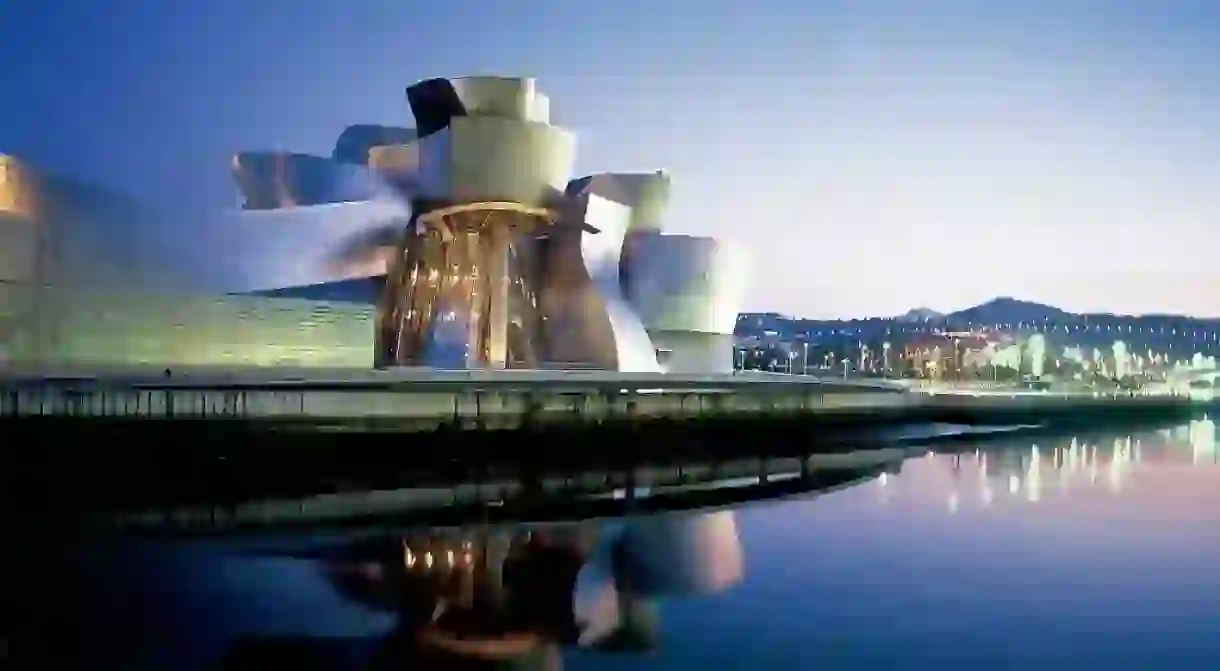Guggenheim Museum Bilbao in 10 Amazing Artworks

Bilbao’s Guggenheim Museum is one of the world’s leading modern art museums, showcasing a range of work by some of the 20th and 21st century’s most important artists. Here, we’ve picked 10 of the museum’s most amazing artworks to share with you.
“Untitled” by Mark Rothko
This classic Mark Rothko piece was painted between 1952 and 1953, and features his iconic large-scale blocks of bright colors. Rothko, an American artist, is one of the central figures of the New York School, who creates his abstract pieces to illicit “basic human emotions — tragedy, ecstasy, doom, and so on,” from the audience, according to Rothko himself. This piece was first exhibited in the Art Institute of Chicago.

“The Renowned Orders Of The Night” by Anselm Kiefer
Anselm Kiefer was born in Germany just before the end of World War II, and many of his artworks explore the themes surrounding war, as well as the rise of fascism. This piece, entitled “The Renowned Orders Of The Night,” features the artist himself lying on a bed of dry, cracked earth, as if he were a corpse, under a vast starry sky. In his later artworks Kiefer became obsessed with the night sky, and he created a few different artworks exploring its beauty.

“Nine Discourses On Commodus” by Cy Twombly
A series of nine paintings, these artworks by American artist Cy Twombly are based around the brutality, lunacy, and eventual murder of the Roman emperor Aurelius Commodus (161–192 CE). The artist’s signature style has a graffiti-like quality and the mood of these paintings range from serene and calm to violent and horrifying, almost seeming to portray blood and fire.

“The Matter of Time” by Richard Serra
Built between 1994 and 2005, these set of eight sculptures by Richard Serra are made from weathered steel, and showcase the evolution of the artist’s sculptural forms. They range from simple ellipses to complex spirals and perfect spheres. Displayed along narrow corridors within the museum, visitors can take their time passing and observing each one.

“Barge” by Robert Rauschenberg
This piece by Robert Rauschenberg was created using oil and silkscreen on canvas, using the artist’s own photographic images, as well as those from popular media sources. Made from 1962-63, Rauschenberg was influenced by the then little-known Andy Warhol, by using silkscreens and transcribing images onto them such as newspapers, maps, magazine ads and comics.

“Maman” by Louise Bourgeois
One of the Guggenheim’s most iconic pieces, this artwork stands just outside the museum and, at nine meters tall, towers over visitors. A giant spider made from bronze, marble and stainless steel, it was created in 1999 and is one of Louise Bourgeois’ most ambitious projects. Made as a tribute to the artist’s mother, who was a weaver, it looks at the protective nature of mothers, as the spider tries to protect the sac of eggs attached to her stomach.

“How Profound Is The Air” by Eduardo Chillida
This unique sculpture was created in 1996 by Eduardo Chillida, one of the most important Basque artists of the 20th century, and is made from alabaster. Chillida first studied architecture and then moved on to painting, before finally finding sculpture. Many of his sculptures explore form and space, while others represent Basque traditions in agriculture, architecture and industry.

“Large Blue Anthropometry [Ant 105]” by Yves Klein
Created in 1960 by the artist Yves Klein, a postmodern artist ahead of his time, this large scale piece is made from pigment and synthetic resin on paper and mounted on canvas. Klein was known for using rollers instead of brushes, and also using nude models to create marks on the paper – showing bodies in motion.
![“Large Blue Anthropometry [Ant 105]” by Yves Klein](https://cdn-v2.theculturetrip.com/10x/wp-content/uploads/2017/02/klein_y_la-gran-antropometria-azul-ant-105-la-grande-anthropometrie-bleue-ant-105_ca--1960.webp?quality=1)
“Puppy” by Jeff Koons
Located just outside the museum stands this giant “Puppy,” made by the artist Jeff Koons and created in 1992. Made from stainless steel, this enormous West Highland terrier is carpeted in bedding plants and flowers. During the process, Koons employed sophisticated computer modelling techniques to create a work that references the 18th century formal European garden, as well as fusing together two elements that make people happy – puppies and flowers.

“Seascape” by Gerhard Richter
From 1968 to 1970, the artist Gerhard Richter used many of his own photographs as a base for his representational paintings. He revisited this theme in 1975, and again in 1998, when he created this oil on canvas “Seascape” painting, based on an image he took on the island of Tenerife in the Canary Islands, Spain.














